
Loch Fleet is a sea loch on the east coast of Scotland, located between Golspie and Dornoch. It forms the estuary of the River Fleet, a small spate river that rises in the hills east of Lairg. The loch was designated a National Nature Reserve (NNR) in 1998, and is managed by a partnership between NatureScot, the Scottish Wildlife Trust (SWT) and Sutherland Estates. The NNR extends to 1058 hectares, including the Loch Fleet tidal basin, sand dunes, shingle ridges and the adjacent pine woods, including Balbair Wood and Ferry Wood. The tidal basin of the loch covers over 630 ha, and forms the largest habitat on the NNR.
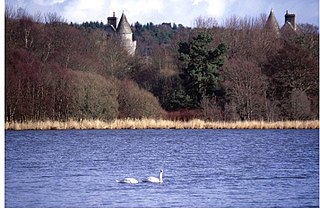
Loch of Skene is a large lowland, freshwater loch in Aberdeenshire, Scotland. It lies approximately 1 mi (1.6 km) to the west of the village of Kirkton of Skene and 9 mi (14 km) west of Aberdeen.

Gibraltar Point national nature reserve is an area of about 4.3 km2 (1.7 sq mi) on the coast of Lincolnshire, England.
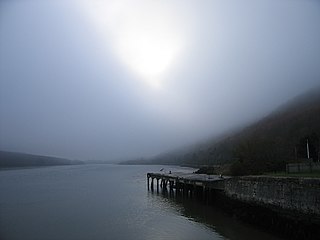
Carlingford Lough is a glacial fjord or sea inlet that forms part of the border between Northern Ireland to the north and the Republic of Ireland to the south. On its northern shore is County Down and on its southern shore is County Louth. At its extreme interior angle it is fed by the Newry River and the Newry Canal.
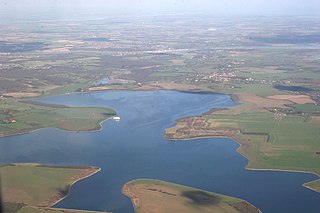
Abberton Reservoir is a freshwater storage reservoir in eastern England near the Essex coast. It is the largest freshwater body in the county and the fourth largest reservoir in England, with an area of 700 hectares (1,700 acres). It is a pumped storage reservoir, with water pumped into it from the River Stour. It lies 6 km (3.7 mi) south-west of Colchester near the village of Layer de la Haye. It is owned and managed by Essex and Suffolk Water, part of Northumbrian Water Group. Plans to increase the capacity of Abberton reservoir to 41,000 megalitres (9.0×109 imp gal) by raising its bank height were completed in 2013.

The Cobourg Peninsula is located 350 kilometres (217 mi) east of Darwin in the Northern Territory, Australia. It is deeply indented with coves and bays, covers a land area of about 2,100 square kilometres (811 sq mi), and is virtually uninhabited with a population ranging from about 20 to 30 in five family outstations, but without any notable settlement or village. It is separated from Croker Island in the east by Bowen Strait, which is 2.5 kilometres wide in the south and up to 7 kilometres in the north, and 8.5 kilometres long. In the west, it is separated from Melville Island by Dundas Strait. From Cape Don, the western point of the peninsula, to Soldier Point in the east of Melville Island, the distance is 28 kilometres (17 mi). In the north is the Arafura Sea, and in the south the Van Diemen Gulf. The highest elevation is Mount Roe in the south with an altitude of 160 metres (525 ft).

Nigula Nature Reserve is a nature reserve situated in South-West of Estonia, in Häädemeeste and Saarde parishes of Pärnu County. It has an area of 63.98 km². Nigula nature reserve is one of the oldest bog reserves in Estonia. It is established to protect the Nigula Bog and its surrounding forests in their natural state.

The Dee Estuary is a large estuary by means of which the River Dee flows into Liverpool Bay. The estuary starts near Shotton after a five-mile (8 km) 'canalised' section and the river soon swells to be several miles wide forming the boundary between the Wirral Peninsula in north-west England and Flintshire in north-east Wales.

Loch Ruthven is a large loch which lies to the southeast of Loch Ness in the Highland region of Scotland. It is 2.25 miles (3.62 km) long, extends over an area of 368 acres (149 ha) and is up to 42 feet (13 m) deep. The most important breeding site in the UK for Slavonian grebes, it has one of the highest populations of this species in Europe. These rare birds can also be found in several other local lochs. The RSPB has established a reserve at Loch Ruthven.

North Roe is a village, and protected area at the northern tip in the large Northmavine peninsula of the Mainland of Shetland, Scotland. It is a small village, with a school with less than a dozen pupils in 2011. The moorland plateau to the south-west of the settlement is part of the Ronas Hill-North Roe and Tingon internationally recognised wetland site, protected under the terms of the Ramsar Convention on Wetlands, and also a Special Protection Area under the Birds Directive. The village is served by the A970 road which runs the length of the Shetland mainland from south to north and is a single-carriageway for the final nine miles.
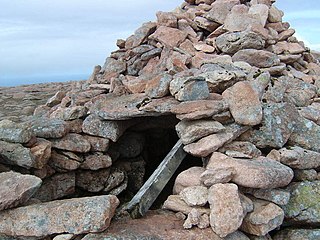
Ronas Hill is a hill in Shetland, Scotland. It is classed as a Marilyn, and is the highest point in the Shetland Islands at an elevation of 450 m (1,480 ft). A Neolithic chambered cairn is located near the summit.
Seven Island Lake Nature Reserve is a nature reserve established in 1956 around Oświn Lake in north-eastern Poland, close to the border with the Kaliningrad Oblast of Russia.

Świdwie is a lake in north-western Poland, and is the site of a nature reserve and a Ramsar site.

Many parts of Wales are protected areas, according to a number of designations. They include three national parks, and five Areas of Outstanding Natural Beauty.
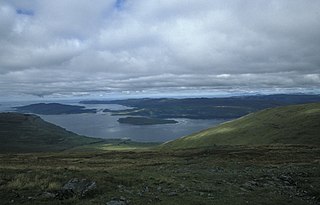
Loch na Keal, meaning Loch of the Kyle, or Narrows, also Loch of the Cliffs, is the principal sea loch on the western, or Atlantic coastline of the island of Mull, in the Inner Hebrides, Argyll and Bute, Scotland. Loch na Keal extends over 20 kilometres (12 mi) inland, almost bisecting Mull, and extending to within 5 km (3 mi) of the eastern shore. The loch gives its name to the Loch na Keal National Scenic Area, one of forty national scenic areas in Scotland.

St Magnus Bay is a large coastal feature in the north-west of Mainland Shetland, Scotland. Roughly circular in shape with a diameter of about 19 kilometres (12 mi), it is open to the North Atlantic Ocean to the west. The indented coastline to the north, south and east between Esha Ness in the north and the Ness of Melby in the south contains numerous bays, firths and voes and there are several islands around the perimeter. The waters of the bay are up to 165 metres (541 ft) deep and may have been the site of a substantial meteor impact.

Many parts of Scotland are protected in accordance with a number of national and international designations because of their environmental, historical or cultural value. Protected areas can be divided according to the type of resource which each seeks to protect. NatureScot has various roles in the delivery of many environmental designations in Scotland, i.e. those aimed at protecting flora and fauna, scenic qualities and geological features. Historic Environment Scotland is responsible for designations that protect sites of historic and cultural importance. Some international designations, such as World Heritage Sites, can cover both categories of site.

The wildlife of Greece includes the diverse flora and fauna of Greece, a country in southern Europe. The country is mostly mountainous with a very long, convoluted coastline, consisting of peninsulas and many islands. The climate ranges from Mediterranean through temperate to alpine, and the habitats include mountains, hills, forests, rivers, lakes, coasts and cultivated land.

Ronas Voe is a voe in Northmavine, Shetland. It divides the land between Ronas Hill, Shetland's tallest mountain, and the Tingon peninsula. It is the second largest voe in Shetland, the largest being Sullom Voe. The townships of Heylor, Voe and Swinister are located on its shores, and the township of Assater is under a kilometre away.
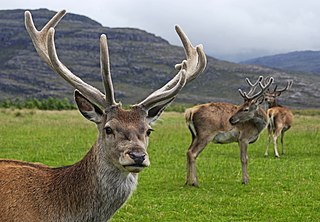
This page gives an overview of the structure of environmental and cultural conservation in Scotland, a constituent country of the United Kingdom.




















